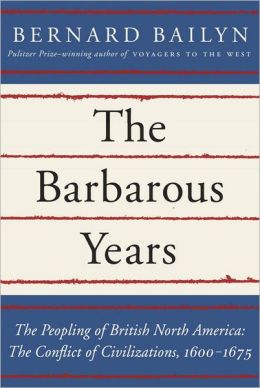
Jeremy provided a thoughtful gift this past Christmas, The Barbarous Years: The Conflict of Civilizations, 1600-1675 by Bernard Bailyn published by Alfred A. Knopf in 2012. Bailyn's book recounts in great (and unpleasant) detail just how it was that the originally small but regularly repeated wavelets of European immigrants (and emigrants, many returned to Europe; huge numbers died here) made lives for themselves in an extraordinarily hostile environment. Except for the "primitive" Finns, European city and village life had not prepared folks for frontier living, and repeated brutal conflicts with the native populations was indeed "barbarous."
Three particular accounts stand out. First, in my part of the City (formerly County) of Suffolk there are several references to "Bennett's" as in Creek, Pasture Road, etc. I had thought this was simply a reference to the land of a farmer who had sold to developers at a hefty profit a couple of decades ago. Instead, I learned that Edward Bennett, a separatist member of the Virginia Company settled "Bennett's Welcome" on the south side of the James River in what is today Suffolk between 1618 and 1621. Problems with both the Indians and the Anglican-dominated balance of the Virginia Company settlements led Edward's son Richard, who was more Puritan than Pilgrim in church polity, eventually to relocate the entire settlement to Maryland where, in spite of oaths of loyalty to the Roman Catholic Calvert family, he helped lead a rebellion against their control of the Maryland Colony during Cromwell's Protectorate.
I was also surprised to read of the mass extermination of the Pequot Indian band by everyone in New England beginning in 1636. Led by the Puritans of Massachusetts and Connecticut, with full support of the Pilgrims and even Roger Williams, they committed what today would be called genocide in the annihilation of all Pequots (at least 900) for the murders of two or three whites.
Indeed, of all the European settlers of the first 75 years of colonization, only the Dutch in New Amsterdam and settlements to the north along the Hudson River expressed any qualms about killing all natives who had not converted to Christianity (and very few had) who were in any way affiliated with those who had attacked the settlers.
Bailyn's scholarship is outstanding. He has clearly mined all the primary sources (letters, diaries, sermons) and utilized the monographs of others who have done the tedious work of tracing settlement patterns from America back to Europe and the trading patterns among European cities, the American settlements, the Spanish Caribbean, and Portuguese Africa. The depth of scholarship reminds me of why I like history but could never have been an historian. A fine book that I don't recommend to everyone but a great resource to fill in "the rest of the story" that you don't learn at places like Jamestown, Virginia or Plymouth, Massachusetts.




Don't know if you read comments on 2013 posts but I linked to this from your recent post about Bailyn. I recall reading The Uprooted as an undergraduate and finding it very moving. He inspired me to take an MA in history (at Yale) before deciding to go to law school. I once met Pelikan at a seminar in Chicago and have managed to get through volume 1 of his History of Christianity. I have spent some time doing pension law reform in countries that follow both the common law and the civil law. That experience gave rise to some untested theories about the superiority of common law in promoting economic growth although I have misgivings about where that growth fits into the hierarchy of values. odbrusta@aol.com
ReplyDelete